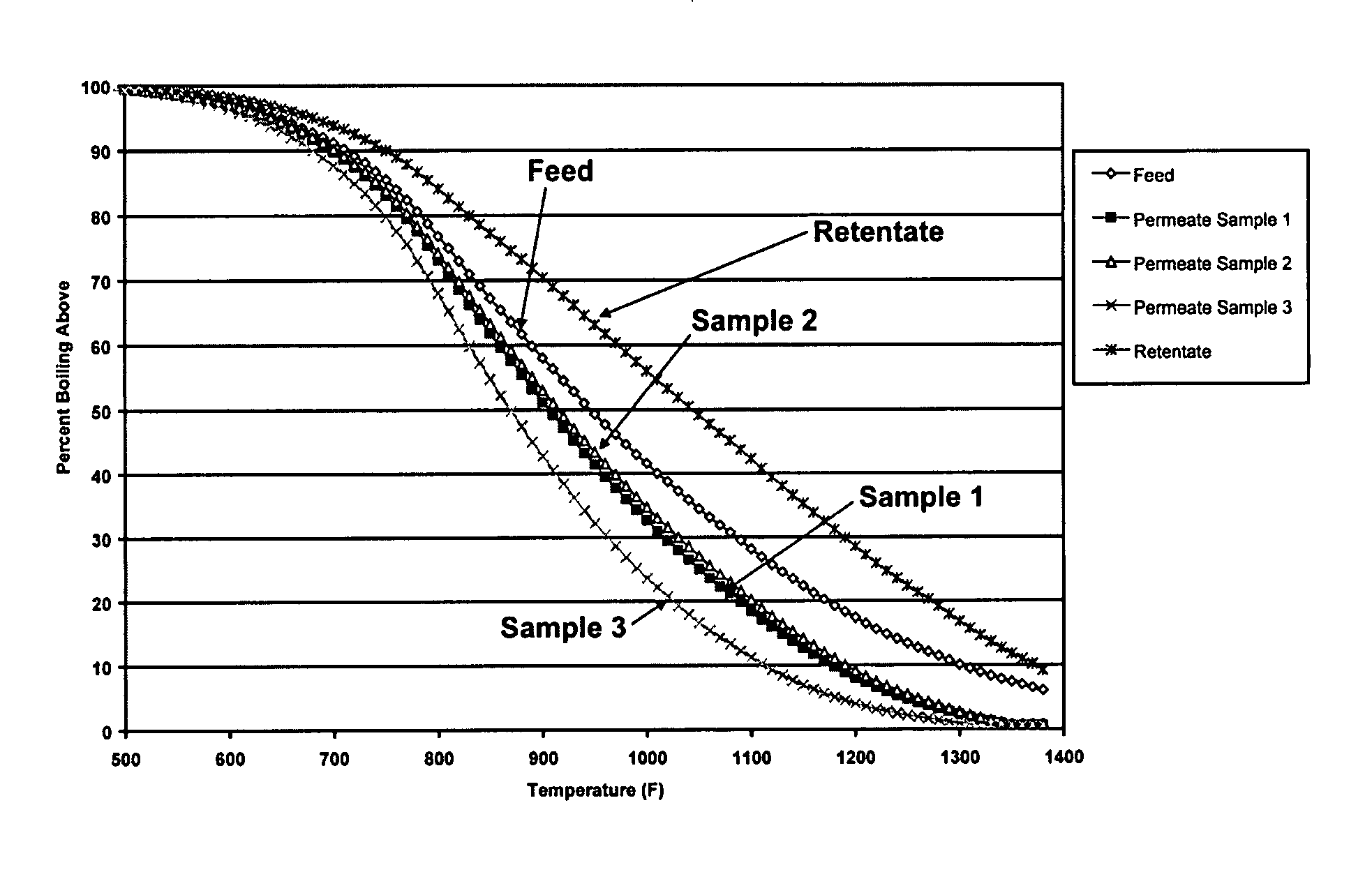Reduction of conradson carbon residue and average boiling points utilizing high pressure ultrafiltration
a technology of conradson carbon and boiling point, applied in the direction of solvent extraction, membrane separation, separation process, etc., can solve the problems of unacceptable high rate for practical or optimal commercial, increase the amount of overall heavy, and exceed the optimum catalyst coking and catalyst deactivation rate, so as to improve the low-energy membrane separation process and improve the effect of ccr conten
- Summary
- Abstract
- Description
- Claims
- Application Information
AI Technical Summary
Benefits of technology
Problems solved by technology
Method used
Image
Examples
example 1
[0034]In this Example, an Arab Light Atmospheric Resid was utilized as a feedstream to the membrane separation zone according to one embodiment of this invention. The properties of the Arab Light Atmospheric Resid feedstream utilized in this example are shown in Table 1 below.
[0035]
TABLE 1Density @Viscosity @Viscosity @Feedstream70° C.40° C.100° C.MCRSulfurDescription(g / cm3)(cP)(cP)(wt %)(wt %)Arab Light0.9518283510.13.3Atmos Resid
[0036]A membrane element consisting of 0.03 micron porous nylon was utilized in the membrane separation zone. The membrane separation zone was comprised of an feed inlet zone, which was in fluid contact with one side of the porous membrane. The feed zone was pressurized and stirred to keep the feed composition properly mixed. A permeate stream was drawn during testing from a permeate zone located on the opposite side of the porous membrane from the feed zone. In this batch experiment, the feed / retentate was not sampled until the end of the experiment and b...
example 2
[0042]In this example, a test was run in a similar fashion to the test described in Example 1 above, with the exception that the membrane utilized in the membrane separation zone was an expanded polytetrafluoroethylene (“PTFE”) membrane and the feedstream to the membrane separation zone utilized in this example was a pentane deasphalted oil recovered from the Arab Light Atmospheric Resid described in Table 1 of Example 1, above. The PTFE membrane had a permeability classification of 5000 Gurley Seconds.
[0043]As similar to Example 1, the pressure of the feedstream was varied during the testing of this example. The permeate zone was held at approximately atmospheric pressure and approximately the same temperature as the feed zone. The MCR of the feedstream was tested at the beginning and at the end of the test run and the permeate samples were periodically drawn during the test and the MCR content was measured. Flux rates and cumulative yields were also measured during the test. The t...
example 3
[0048]In this example, an improved permeate product stream was obtained by ultrafiltration of an atmospheric resid feedstream separated utilizing a ceramic 5 kD (kiloDalton) cutoff membrane. The average pore size of the membrane was estimated to be about 0.005 microns (μm). The samples utilized for the atmospheric resid feedstream were two portions of a single sample of atmospheric resid. There was some slight variation shown in the initial MCR testing of the two test runs. In the first test run, one portion of the sample was subjected to separation at a feedstream pressure of 500 psig. In the comparative test run the second portion was tested under the same conditions except at a much higher feedstream pressure.
[0049]The results of the two comparative tests are shown in Tables 4 and 5, below. The terms and test methods in the tables of this example are similar to those utilized in Examples 1 and 2 above. The permeate zone pressure was held at approximately atmospheric pressure and ...
PUM
| Property | Measurement | Unit |
|---|---|---|
| pore size | aaaaa | aaaaa |
| boiling point | aaaaa | aaaaa |
| transmembrane pressure | aaaaa | aaaaa |
Abstract
Description
Claims
Application Information
 Login to View More
Login to View More - R&D
- Intellectual Property
- Life Sciences
- Materials
- Tech Scout
- Unparalleled Data Quality
- Higher Quality Content
- 60% Fewer Hallucinations
Browse by: Latest US Patents, China's latest patents, Technical Efficacy Thesaurus, Application Domain, Technology Topic, Popular Technical Reports.
© 2025 PatSnap. All rights reserved.Legal|Privacy policy|Modern Slavery Act Transparency Statement|Sitemap|About US| Contact US: help@patsnap.com


